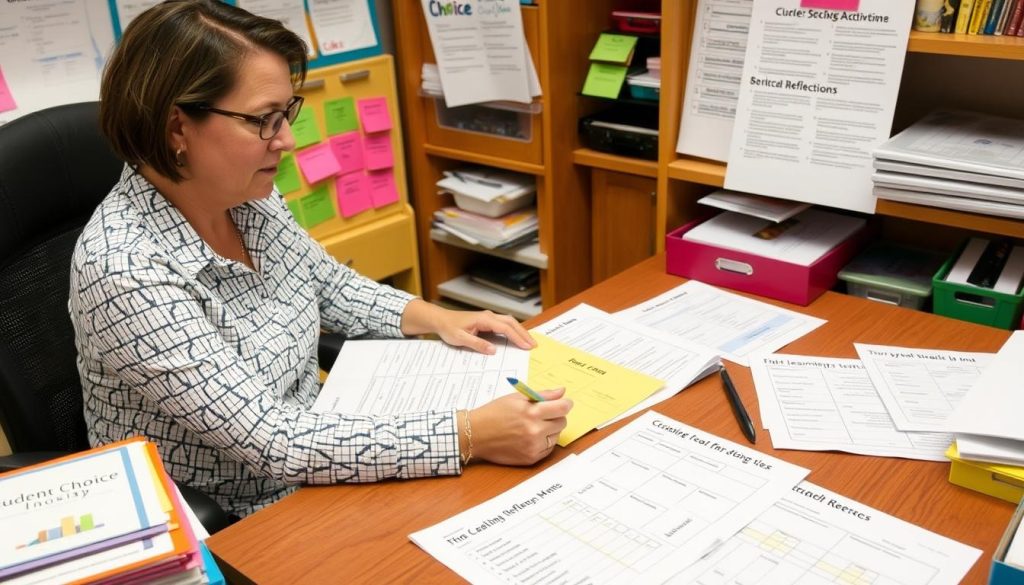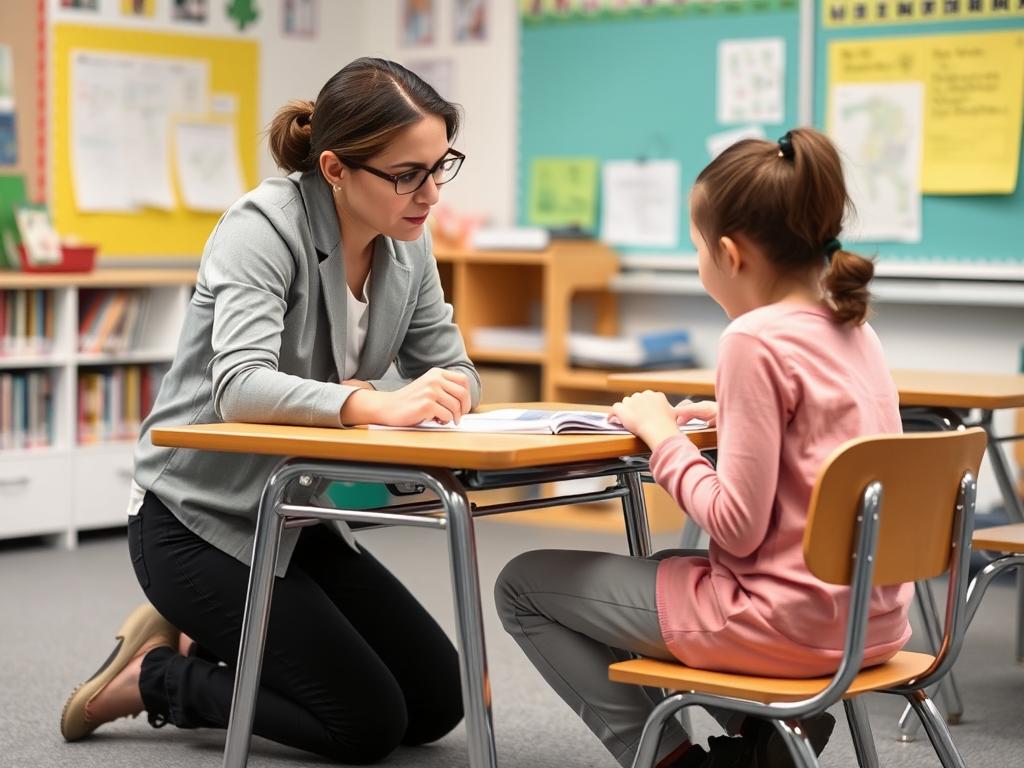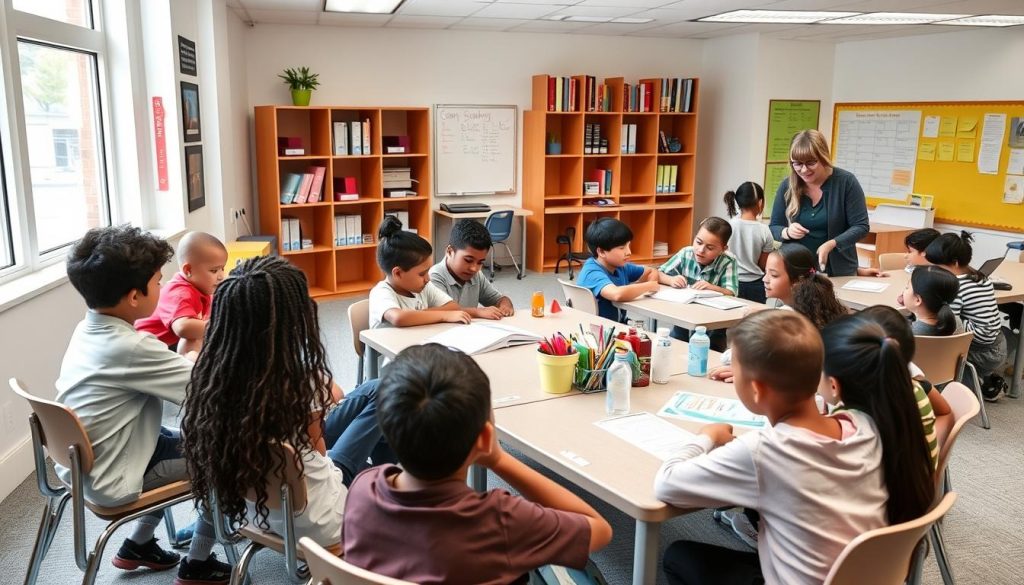Understanding the Importance of Student Choice in Education
Students thrive when given meaningful choices in their learning journey
The importance of student choice extends far beyond simply letting students pick their activities. Research consistently shows that when students have agency in their learning process, they develop stronger academic skills, greater motivation, and improved self-regulation. According to a 2014 study published in The Journal of Educational Research, students who were given choices in their reading materials showed increased reading volume and significant improvements in test performance compared to those with assigned reading only.
Offering students choices—making it a regular dynamic in the school day—isn’t a recipe for chaos as some might fear. Rather, it’s about creating structured opportunities for students to exercise decision-making within appropriate boundaries. Developing these teacher skills requires understanding that rules and structure remain essential, but within that framework, students can make meaningful decisions about their learning paths.
As educators enhance their teacher skills in this area, they discover that student choice can be implemented across all subject areas and grade levels. From kindergarteners choosing which center to visit first, to high school students selecting research topics or assessment formats, the importance of student choice remains consistent throughout a child’s educational journey.
Ready to transform your classroom with student choice?
Discover proven strategies and practical techniques for implementing effective student choice in your classroom with our comprehensive professional development course.
Key Benefits: The Importance of Student Choice for Learning Outcomes
Understanding the full spectrum of benefits that come with implementing student choice helps educators prioritize this approach in their teaching practice. As you develop your teacher skills in this area, you’ll witness these positive outcomes firsthand:
Increased Motivation and Engagement
When students have a voice in their learning, they develop intrinsic motivation rather than simply complying with teacher directives. This shift from external to internal motivation is powerful—students work harder and persist longer when they feel ownership over their learning. The importance of student choice becomes evident as engagement levels rise across all student populations.
Development of Critical Thinking
Making choices requires students to evaluate options, consider consequences, and make decisions—all crucial critical thinking skills. By regularly practicing these teacher skills in your classroom, you help students develop higher-order thinking abilities that transfer across subjects and into real-world situations.
Improved Self-Regulation
Student choice fosters self-regulation as learners must monitor their progress, adjust their approach when needed, and take responsibility for their learning outcomes. These executive function skills are essential for success both in and beyond the classroom.
Greater Academic Achievement
Multiple studies have shown that when students have choice in their learning, academic performance improves. This connection between the importance of student choice and achievement highlights why developing these teacher skills is so valuable for educators.

Individual conferencing allows teachers to guide students in making effective choices
Perhaps most importantly, implementing student choice helps create a classroom environment where diversity is celebrated. Each student brings unique strengths, interests, and learning preferences. When teacher skills include the ability to offer meaningful choices, every student has opportunities to shine and contribute in ways that align with their individual profiles.
The importance of student choice becomes particularly evident for students who have previously struggled in traditional educational settings. When given appropriate options, these students often find pathways to success that weren’t available in one-size-fits-all approaches.
Implementing the Importance of Student Choice in Elementary Classrooms
Elementary classrooms offer fertile ground for introducing student choice. Young learners are naturally curious and eager to explore, making this an ideal time to begin developing their decision-making abilities. Here are practical strategies for elementary teachers to enhance their teacher skills in implementing student choice:
Choice Boards and Learning Menus
Choice boards provide a structured way to offer options while ensuring all students master essential content. Create a grid of activities that address the same learning objectives but through different modalities. Students can choose which activities to complete, often with requirements like “pick one activity from each row” or “complete any three activities.”
Choice boards offer structured options while ensuring curriculum coverage
Flexible Seating Arrangements
The physical environment plays a crucial role in learning. Offering flexible seating options allows students to choose where they work best—whether at traditional desks, on floor cushions, at standing tables, or in quiet corners. This simple application of the importance of student choice helps children learn to identify and select environments that support their learning needs.
Reading and Writing Workshops
Workshop models exemplify the importance of student choice in literacy instruction. During reading workshops, students select books that interest them while teachers provide guidance on appropriate reading levels. In writing workshops, students choose topics they care about, increasing investment in the writing process. These approaches require specific teacher skills in conferencing, providing differentiated support, and balancing structure with freedom.
Project-Based Learning with Options
Even young students can engage in project-based learning with appropriate scaffolding. Provide several project options that demonstrate the same learning objectives, allowing students to select the approach that most interests them. This might include creating a poster, building a model, writing a story, or recording a presentation.
Remember that introducing choice to young learners requires thoughtful scaffolding. Start with limited, clear options and gradually expand choices as students develop their decision-making skills. The teacher skills needed here include creating appropriate boundaries, providing clear instructions, and helping students reflect on their choices.
Enhance your elementary teaching with student choice strategies
Access grade-specific resources and lesson plans that make implementing student choice manageable and effective in your elementary classroom.
The Importance of Student Choice in Middle and High School Settings
Adolescents have a developmental need for autonomy and independence, making the importance of student choice particularly significant in secondary education. As students mature, they can handle more complex choices and greater responsibility. Here are strategies specifically designed for middle and high school settings:

Secondary students benefit from collaborative decision-making opportunities
Assessment Choice
Offering options for how students demonstrate their learning is a powerful application of student choice. For example, after studying a historical period, students might choose to create a documentary, write a research paper, design a museum exhibit, or develop a dramatic presentation. Each option requires the same content knowledge but allows students to leverage their individual strengths.
Curriculum Co-Creation
Involve students in designing aspects of the curriculum. This might include selecting texts for literature circles, voting on research topics within a broader theme, or developing essential questions to guide a unit. These teacher skills demonstrate trust in students’ capabilities while ensuring alignment with required standards.
Personalized Learning Pathways
Technology makes it increasingly possible to offer personalized learning paths. Using adaptive learning platforms, students can progress at their own pace, choose from different learning resources, and select practice activities that match their needs. The teacher skills required here include data analysis, providing targeted support, and helping students make wise choices about their learning progression.
Student-Led Conferences and Goal Setting
Involve students in the assessment process through student-led conferences where they present their work, reflect on their progress, and set goals for future learning. This approach honors student voice while developing crucial metacognitive skills.
Secondary teachers often worry that offering choice might compromise academic rigor. However, when implemented thoughtfully, the importance of student choice actually enhances rigor by increasing student investment and effort. The key teacher skills involve designing choice opportunities that maintain high expectations while allowing for personalization.
“Want to know how to engage students, enthuse them, and bring out their best effort? Give them a voice in their decisions. In a society that barely listens to each other, listen to your students.”
– Heather Wolpert-Gawron, Middle School Teacher
The importance of student choice becomes even more evident when working with disengaged adolescents. Many secondary teachers find that offering meaningful choices can re-engage students who have become passive or resistant learners. Developing these teacher skills can transform classroom dynamics and create more positive learning environments.
Practical Steps to Implement the Importance of Student Choice
Moving from theory to practice requires specific teacher skills and a thoughtful approach. Here’s a step-by-step guide to implementing student choice in your classroom:

Thoughtful planning is essential for effective implementation of student choice
1. Start Small and Build Gradually
Begin with limited, structured choices before expanding to more open-ended options. For example, start by offering two or three well-defined choices for an assignment before moving to more complex choice boards or completely open projects. This gradual approach helps both you and your students develop the necessary skills for successful implementation.
2. Establish Clear Parameters
The importance of student choice doesn’t mean unlimited freedom. Clearly communicate the learning objectives, quality criteria, and boundaries for each choice opportunity. These parameters provide the structure students need to make meaningful decisions while ensuring academic standards are met.
3. Teach Decision-Making Skills
Don’t assume students automatically know how to make good choices. Explicitly teach decision-making strategies, help students identify their learning preferences, and guide them in matching choices to their needs. These teacher skills help students develop metacognition and self-awareness.
4. Create Systems for Accountability
Develop routines for tracking student choices, monitoring progress, and ensuring completion. This might include choice tracking sheets, regular check-ins, or digital tools that help students manage their learning paths. Effective teacher skills in this area balance student autonomy with appropriate oversight.
5. Reflect and Refine
Regularly gather feedback from students about choice opportunities. Which options were most engaging? Which helped them learn best? Use this information to refine your approach and develop your teacher skills in implementing student choice.
Master the implementation of student choice in your classroom
Our comprehensive course provides step-by-step guidance, ready-to-use templates, and expert strategies for successfully implementing student choice.
Remember that implementing the importance of student choice is itself a learning process. You’ll refine your teacher skills over time as you observe what works best for your specific students and teaching context. Be willing to experiment, adjust, and sometimes step back when a particular approach isn’t working as intended.
Addressing Common Challenges to the Importance of Student Choice
While the benefits of student choice are clear, implementation comes with challenges. Developing your teacher skills includes learning to navigate these potential obstacles:
Common Concerns
- Students might make poor choices
- Classroom management could become more difficult
- Covering required curriculum might be compromised
- Planning for multiple options requires more time
- Assessment becomes more complex
Effective Solutions
- Scaffold choice-making with appropriate guidance
- Establish clear expectations and boundaries
- Design choices that all address core standards
- Create reusable choice structures and templates
- Develop flexible rubrics that work across choice options
When Students Make Poor Choices
It’s inevitable that students will sometimes make choices that don’t serve their learning well. View these moments as valuable teaching opportunities rather than failures of the approach. The teacher skills needed here include conferencing with students, helping them reflect on their choices, and guiding them toward better decisions in the future.
Balancing Choice with Curriculum Requirements
Many teachers worry that emphasizing student choice might compromise curriculum coverage. The key is designing choice opportunities that all address the same essential standards but through different pathways. This approach honors the importance of student choice while ensuring all students master required content.

Supporting students in reflecting on their choices builds decision-making skills
Managing the Logistics
Offering multiple options can create logistical challenges. Develop systems for organizing materials, tracking student choices, and managing different activities simultaneously. These organizational teacher skills are essential for successful implementation of student choice.
Supporting Struggling Decision-Makers
Some students find too many choices overwhelming or consistently make choices that don’t challenge them appropriately. For these learners, provide more structure initially—perhaps offering just two options or using a choice hierarchy that guides them toward appropriate selections. As their decision-making confidence grows, gradually increase the range of choices available.
Remember that the importance of student choice doesn’t mean eliminating teacher guidance. Your expertise remains crucial in designing meaningful options, providing appropriate scaffolding, and helping students develop as independent learners. The most effective teacher skills in this area involve finding the right balance between structure and freedom for each individual student.
Aligning Assessment with the Importance of Student Choice
Assessment practices must evolve alongside instructional approaches that emphasize student choice. Traditional assessment methods often assume all students demonstrate learning in the same way, which contradicts the principles of student choice. Here’s how to develop teacher skills that align assessment with choice-based learning:
Designing Flexible Rubrics
Create rubrics that focus on learning outcomes rather than specific product features. For example, rather than assessing “includes three pictures with captions,” a flexible rubric might assess “effectively incorporates visual elements that enhance understanding of the concept.” This approach allows for diverse demonstrations of learning while maintaining consistent standards.

Student presentations of choice-based projects provide authentic assessment opportunities
Incorporating Self-Assessment
When students have choice in their learning, they should also have a voice in assessing their progress. Teach students to evaluate their work against established criteria, reflect on their learning process, and set goals for improvement. These self-assessment teacher skills help students develop metacognition and take ownership of their learning journey.
Using Performance-Based Assessment
Performance-based assessments allow students to demonstrate learning through authentic tasks rather than traditional tests. These assessments naturally accommodate different approaches and learning styles, making them ideal for classrooms that value the importance of student choice.
Implementing Portfolio Assessment
Portfolios provide a comprehensive view of student learning over time and can include diverse artifacts that represent different choice pathways. The teacher skills needed for effective portfolio assessment include helping students select representative work, guiding reflection, and evaluating growth rather than just final products.
When assessment practices honor the importance of student choice, they reinforce the message that there are multiple valid ways to learn and demonstrate understanding. This alignment between instruction and assessment is crucial for creating a coherent learning environment where student agency is truly valued.
Transform your assessment practices to support student choice
Learn how to create flexible assessment tools that honor student choice while maintaining academic rigor and standards alignment.
Research Supporting the Importance of Student Choice
The importance of student choice isn’t just an educational trend—it’s supported by robust research across multiple disciplines. Understanding this research helps educators develop teacher skills grounded in evidence-based practices:
Motivation and Engagement Research
Self-determination theory, developed by psychologists Edward Deci and Richard Ryan, identifies autonomy as one of three basic psychological needs essential for intrinsic motivation. When students have meaningful choices in their learning, they experience greater autonomy, leading to increased engagement and persistence. This research provides a theoretical foundation for understanding why student choice matters.
Neuroscience Perspectives
Neuroscience research indicates that choice activates reward centers in the brain, releasing dopamine that enhances attention and memory formation. Additionally, when students make choices, they engage executive function networks responsible for decision-making and self-regulation—strengthening these crucial neural pathways through practice.
Neuroscience research shows increased brain activation during choice-based learning
Literacy Research
Multiple studies in literacy education demonstrate the power of choice in reading development. A landmark study by Guthrie and Humenick found that choice in reading materials was one of the most significant factors in improving reading motivation and comprehension. This research has profound implications for developing teacher skills in literacy instruction.
Equity and Inclusion Research
Research on culturally responsive teaching emphasizes the importance of student choice in creating equitable learning environments. When students can make choices that connect learning to their cultural backgrounds, personal interests, and lived experiences, they experience greater belonging and academic success.
This research base provides a compelling rationale for developing teacher skills that incorporate meaningful choice opportunities. By grounding our practices in evidence, we can implement student choice with confidence and purpose, knowing that we’re supporting students’ cognitive, social, and emotional development.
Embracing the Transformative Importance of Student Choice
The importance of student choice extends far beyond simple preference or engagement—it fundamentally shapes how students view themselves as learners and their relationship with education. When we honor student voice and provide meaningful choices, we communicate powerful messages: that we trust students’ capabilities, value their perspectives, and believe in their capacity to direct their own learning.
Developing the teacher skills necessary to implement effective choice opportunities is a journey that unfolds over time. It requires willingness to relinquish some control, embrace flexibility, and view teaching as a collaborative process rather than a one-way transmission of knowledge. Yet the rewards—seeing students become more engaged, self-directed, and confident learners—make this journey well worth the effort.
As you incorporate the importance of student choice into your teaching practice, remember that balance is key. Students need both structure and freedom, guidance and independence, challenge and support. Finding the right balance for your specific students and context is where your professional expertise as an educator becomes most valuable.

Student choice creates vibrant learning communities where every student can thrive
The path to implementing student choice may not always be smooth, but each step builds your teacher skills and creates more empowering learning experiences for your students. By embracing the importance of student choice, you join a community of educators committed to transforming education from a system of compliance to one of agency, engagement, and authentic learning.
Ready to transform your teaching with student choice?
Join thousands of educators who have enhanced their teacher skills and revolutionized their classrooms through our comprehensive student choice course.




